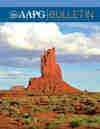盐蚀斜坡上盐冠的生长和演变:物理模型的启示
IF 2.5
3区 地球科学
Q2 GEOSCIENCES, MULTIDISCIPLINARY
引用次数: 0
摘要
盐冠层形成了盐构造领域中最壮观和最复杂的结构。在这项研究中,我们使用两个物理模型来研究盐分离斜坡上盐冠层的生长和演化。在我们的模型中播种了一系列14个喂食器,并作为被动底辟向上生长。最终,这些被动底辟岩以盐片的形式扩散,运动矢量沿强加的区域倾斜斜坡向下倾斜。单个床单之间的缝合线向覆盖的方向弯曲,并随着树冠系统的成熟而被肢解。由于收缩和一次焊接,阵列内部的馈线面临越来越多的盐竞争。相比之下,冠层边缘的取食植物面临较少的竞争,生长更加旺盛,产生了局部高程梯度,并使盐流方向与区域倾斜坡度高度倾斜。最后,我们的模型树冠被推进的沉积物所加载。在其他因素中,冠层的形成受到盐收支的强烈控制,我们的不太成熟的模型形成了一系列小冠层和孤立的盐层。在沉积加载过程中,该模型显示了盐被下驱过程中片内和壳内的膨胀—收缩流细胞。缝合线进一步分散,一些缝合线被拉长。我们的成熟模型的加载使原本连续的冠层收缩,将盐沿一系列碱盐坡道向海推进,形成一个浅层的远端冠层。缝合碎片一直被带到了这个浅树冠的脚趾。我们更成熟的模型在加载前也被缩短,导致冠层再活动、增厚和缝合变形增强。在缩短过程中,盐流被喂食器引导,形成了盐流,其取向通常为斜向至区域倾斜。冠层盐对缩短的反应主要是增厚,而冠层以下的沉积物则表现出相反的情况。在这里,一个复杂的逆冲和撕裂断层网络连接着可变焊接的馈线。本文章由计算机程序翻译,如有差异,请以英文原文为准。
Growth and evolution of salt canopies on a salt-detached slope: Insights from physical models
Salt canopies form the most spectacular and complex structures in the realm of salt tectonics. In this study, we use two physical models to examine salt-canopy growth and evolution on a salt-detached slope. A series of 14 feeders were seeded in our models and grew upward as passive diapirs. Eventually, these passive diapirs spread as salt sheets, with motion vectors skewed down the imposed regional dip slope. Sutures between individual sheets were bowed in the direction of override and became dismembered as the canopy system matured. Feeders in the interior of the array faced increasing competition for salt due to drawdown and primary welding. In contrast, feeders on the canopy peripheries faced less competition and rose more vigorously, generating local elevation-head gradients and imparting salt-flow directions that were highly oblique to the regional dip slope. Finally, our model canopies were loaded by prograding sediments. Canopy formation is strongly controlled by the salt budget, among other factors, and our less mature model formed a series of small canopies and isolated salt sheets. During sedimentary loading, this model displayed intrasheet and intracanopy inflation–deflation flow cells as salt was driven downdip. Sutures were further dispersed, and some were everted. Loading of our mature model deflated the originally continuous canopy, driving salt seaward up a series of base-salt ramps to form a shallow distal canopy. Suture fragments were carried all the way to the toe of this shallow canopy.Our more mature model was also shortened before loading, which resulted in canopy remobilization, thickening, and enhanced suture deformation. Salt flow during shortening was channeled by feeders, forming salt streams with orientations commonly oblique to regional dip. Canopy salt responded to shortening primarily by thickening, whereas the sediments below the canopy displayed a contrasting story. Here, a complex network of thrusts and tear faults linked the variably welded feeders.
求助全文
通过发布文献求助,成功后即可免费获取论文全文。
去求助
来源期刊

AAPG Bulletin
工程技术-地球科学综合
CiteScore
6.60
自引率
11.40%
发文量
73
审稿时长
4.8 months
期刊介绍:
While the 21st-century AAPG Bulletin has undergone some changes since 1917, enlarging to 8 ½ x 11” size to incorporate more material and being published digitally as well as in print, it continues to adhere to the primary purpose of the organization, which is to advance the science of geology especially as it relates to petroleum, natural gas, other subsurface fluids, and mineral resources.
Delivered digitally or in print monthly to each AAPG Member as a part of membership dues, the AAPG Bulletin is one of the most respected, peer-reviewed technical journals in existence, with recent issues containing papers focused on such topics as the Middle East, channel detection, China, permeability, subseismic fault prediction, the U.S., and Africa.
 求助内容:
求助内容: 应助结果提醒方式:
应助结果提醒方式:


